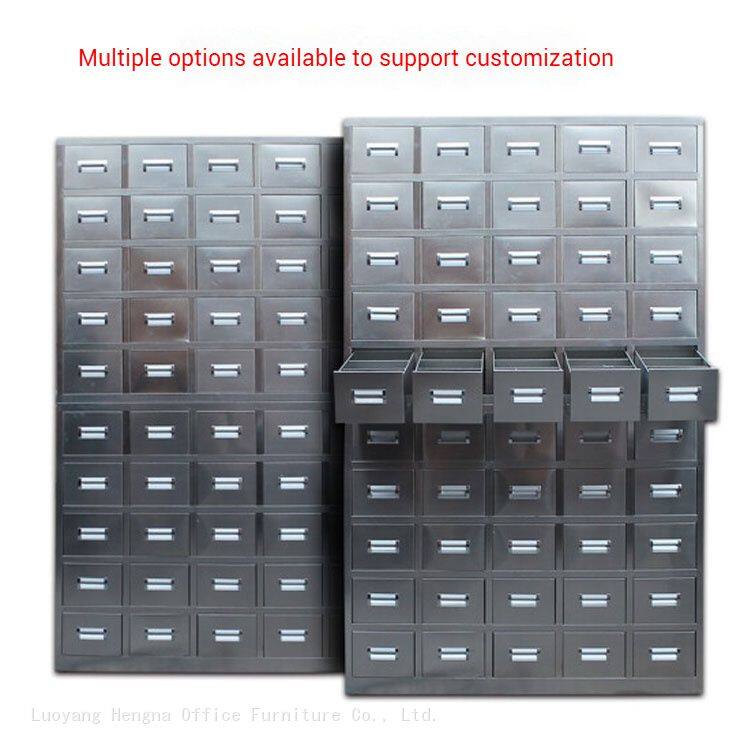Home > Blog > Durable Stainless Steel Herb Cabinets for High-Humidity Environments: What to Look For
-
 Sarah
Hi there! Welcome to my shop. Let me know if you have any questions.
Sarah
Hi there! Welcome to my shop. Let me know if you have any questions.
Your message has exceeded the limit.

Durable Stainless Steel Herb Cabinets for High-Humidity Environments: What to Look For
2025-10-25 17:03:57
In high-humidity environments—whether it’s a bustling herbal pharmacy, a traditional Chinese medicine clinic, or even a home kitchen storing dried herbs—the biggest enemy of herb storage is moisture. Dampness leads to mold growth, rusted metal containers, and spoiled herbs, wasting valuable resources and compromising safety. That’s why choosing a stainless steel herb cabinet is not just a smart choice—it’s a necessity. But with so many options on the market, how do you pick one that truly stands up to humid conditions? Let’s break down the key features to look for, backed by practical tips and real-world benefits.
1. Moisture and Waterproofing: The Non-Negotiable Feature
High humidity means constant exposure to water vapor, which can seep into cabinets and ruin herbs. A top-tier stainless steel herb cabinet must have advanced waterproofing to keep moisture out. Look for cabinets with:
Sealed seams: Gaps between panels or drawers are entry points for damp air. Cabinets with welded or tightly sealed seams prevent moisture from penetrating.
Water-repellent coatings: Some models add a thin, invisible layer that repels water droplets, similar to how rain jackets work. This extra barrier is especially useful in areas with frequent condensation.
Rust-resistant stainless steel: Not all stainless steel is created equal. Opt for 304 or 316 grade stainless steel, which contains chromium and nickel—metals that form a protective oxide layer to resist rust. Cheaper grades (like 201) may corrode over time, especially in humid climates.
Why it matters: A waterproof cabinet keeps your herbs dry, preserving their potency and extending shelf life. No more throwing away moldy ginseng or spoiled goji berries!

2. Rodent and Insect Control: Protect Your Herbs from Unwanted Guests
In humid environments, rodents and insects thrive—they’re attracted to the warmth and potential food sources (your herbs!). A good stainless steel cabinet should have built-in defenses:
Tight-fitting doors and drawers: Gaps larger than 1/8 inch are enough for mice to squeeze through. Choose cabinets with magnetic seals or soft-close mechanisms that create an airtight fit.
Smooth, seamless interiors: Rough surfaces or cracks can harbor insects like beetles or moths. Stainless steel’s smooth finish makes it hard for pests to hide or lay eggs.
Integrated pest deterrents: Some premium cabinets include subtle features like raised edges on shelves or removable trays that make it harder for pests to climb or nest.
Pro tip: If you’re storing highly aromatic herbs (like cinnamon or cloves), pests are even more likely to target them. A rodent-proof cabinet gives you peace of mind.
3. Thin Edges: Maximize Space Without Sacrificing Durability
“Thin edges” might sound trivial, but in herb storage, every inch counts. Traditional cabinets often have thick, bulky frames that eat up internal space—meaning you can’t store as many herbs. Modern stainless steel cabinets solve this with:
Slim-profile designs: Frames and edges are minimized, so the interior space is larger relative to the cabinet’s overall size. For example, a cabinet with 2-inch thick edges might have 20% less usable space than one with 0.5-inch edges.
Modular shelving: Many models come with adjustable or removable shelves, allowing you to customize the layout for different herb sizes (e.g., tall ginseng roots vs. small goji berries).
Real-world benefit: Whether you’re a small business owner trying to maximize inventory or a home user with limited space, thin-edge cabinets let you store more without cluttering your room.
4. Large Capacity: Stock Up and Stay Organized
For clinics, pharmacies, or avid herbalists, large capacity is a game-changer. It means you can buy herbs in bulk (saving money) and keep them organized for easy access. Look for cabinets with:
Multiple drawers or shelves: Drawers are ideal for sorting herbs by type (e.g., roots in one drawer, leaves in another). Shelves work well for larger items like dried mushrooms.
Adjustable dividers: These let you create custom compartments within drawers, so you don’t have to mix different herbs together.
Stackable designs: If you need even more space, some cabinets can be stacked vertically—perfect for growing businesses.
Example: A large-capacity cabinet might hold 50+ jars of herbs, compared to a smaller one that only fits 20. Over time, that’s a huge difference in efficiency!
5. Corrosion-Resistant Stainless Steel Grades
The type of stainless steel used in your cabinet is crucial for high-humidity environments. Here’s a comparison of the most common grades:
| Grade | Composition | Best For | Humidity Resistance |
|---|---|---|---|
| 201 | Basic stainless steel with less chromium/nickel | Budget-friendly options | Poor - prone to rust in humidity |
| 304 | 18% chromium, 8% nickel | Most home and commercial use | Good - resists most corrosion |
For high-humidity environments, always choose 304 or 316 grade stainless steel. The extra cost is worth it for the longevity and protection it provides.
6. Quality Hardware: The Details That Matter
Small details like handles and hinges can make a big difference in how well your cabinet performs in humid conditions:
High-grade aluminum alloy handles: As shown in the reference image, quality handles are durable and resistant to fading. They won’t corrode or deteriorate in moist environments.
Stainless steel hinges and slides: Ensure all metal components are made of corrosion-resistant materials. Cheap hardware will rust quickly, making drawers difficult to open and close.
Soft-close mechanisms: These prevent slamming and reduce wear on the cabinet structure, extending its lifespan in humid conditions.
Why Stainless Steel Beats Other Materials
You might wonder: “Why not use wood or plastic cabinets?” Here’s why stainless steel is superior in humid environments:
Durability: Stainless steel doesn’t warp, crack, or rot like wood. It can withstand years of use—even in steamy kitchens or rainy climates.
Easy cleaning: Wipe it down with a damp cloth and mild soap; no need for special treatments or sealants. Plastic cabinets can scratch easily and trap odors.
Hygiene: Stainless steel is non-porous, so it doesn’t absorb moisture or bacteria. Wood, on the other hand, can harbor mold if not properly sealed.

Final Tips for Choosing the Right Cabinet
Before you buy, ask yourself these questions:
How much space do I need? Measure the area where the cabinet will go and choose a size that fits (with room for airflow around it).
What kind of herbs am I storing? Delicate herbs (like chrysanthemum) need more protection than hardy ones (like licorice root). Look for cabinets with adjustable humidity control if possible.
Is it easy to assemble? Some stainless steel cabinets come pre-assembled; others require minimal setup. If you’re not handy, opt for the former.
A durable stainless steel herb cabinet is an investment in your health, your business, and your peace of mind. By prioritizing moisture resistance, pest control, space-saving design, and large capacity, you’ll protect your herbs from spoilage and ensure they stay fresh for months (or even years).
Whether you’re running a clinic or simply love using natural remedies at home, the right cabinet will make all the difference. Don’t settle for subpar storage—choose a stainless steel herb cabinet that’s built to last in high-humidity environments. Your herbs (and your wallet) will thank you!
Bonus: When shopping, check customer reviews for feedback on durability and moisture resistance. A reputable brand will stand behind its product with a warranty—another sign of quality. Happy herb storing!
Tags: Durable Stainless Steel Herb Cabinets, Stainless Steel Herb Cabinets for High-Humidity Environments

